

European
Nuclear Society
e-news
issue 50: February 2016
The past few months were characterised by a rush to finalise 2015 and not leave anything unfinished. The organised and orderly start to 2016 shows that we did a good job with this task. At the European Nuclear Society, we find ourselves between two very important events in history: the up-coming celebration of the 40th anniversary of ENS in Amsterdam in April and the COP21 climate change conference which took place in Paris in December.
To mark the 40th anniversary, ENS is organising a special event to be held in Amsterdam on 6 and 7 April 2016 in cooperation with the Dutch presidency of the Council of the EU. Now that the Society moves into its forties, it is an opportunity to take a look at how far nuclear technology has come and to peer into the future of the various applications from which we benefit. After all, leading-edge nuclear technologies lead to innovative industrial applications, improve quality of life and create new markets.
For example, Europe is a major player in research and development of nuclear medicine. We have been using nuclear technology for medical applications for nearly a century. Globally, eight reactors (five of which in the EU) provide the radio-isotopes used for medical and radiation therapy purposes.
Nuclear technology is also widely used for industrial applications. One example which is increasingly becoming more important is the production of neutron-doped silicon used in solar pv panels, wind turbines and high-speed trains, among others. Renewable energy generation sources are becoming more widespread all over the world but the manufacturing of these installations would be impossible without nuclear technology.
Let us not forget that we would also be unable to continue with our exploration of the deepest reaches of space without nuclear power sources. The Mars rover Curiosity, which has become famous world-wide with its staggering photos from the Red Planet, is powered by a perpetual nuclear power source. Several other probes, such as Voyager, have reached the edges of our Solar System only because of nuclear energy sources.
To develop this technology, the global nuclear industry has had to cooperate. The continuous development of nuclear technology has taken us from the targeted destruction of infected cells in our bodies to the farthest reaches of the galaxy. With continued cooperation, only time will tell what human-kind can achieve!
At the same time, we should not forget that nuclear power has a large role to play in the sustainable development of the human environment. An historic agreement to combat climate change and unleash actions and investment towards a low carbon, resilient and sustainable future was agreed by the 195 nations present in Paris in December 2015. Its main aim is to keep a global temperature rise this century “well below 2 degrees Celsius” and to drive efforts to limit the temperature increase even further to 1.5 degrees Celsius above pre-industrial levels. According to the latest scientific reports, global temperatures have already risen by almost 1 degree Celsius.
The Paris Agreement and the outcomes of the UN climate conference (COP21) cover all the crucial areas identified as essential for a landmark conclusion. As well as setting a long-term direction, countries will peak their emissions as soon as possible and continue to submit national climate action plans that detail their future objectives to address climate change. This builds on the momentum of the unprecedented effort which has so far seen 188 countries contribute climate action plans to the new agreement, which will dramatically slow the pace of global greenhouse gas emissions. In fact, two contributions were submitted the day the Agreement was adopted.
During COP21, the Nuclear for Climate initiative was present in both the Gallery of Solutions and the so-called Blue Zone, where negotiations took place. The booth at the Gallery organised several events with nuclear experts and pro-nuclear environmentalists to inform attendees of the benefits of using nuclear energy as part of the solution to fighting climate change. Also present in the Blue Zone were two international organisations on nuclear energy: the International Atomic Energy Agency (officially a UN organisation) and the OECD Nuclear Energy Agency (OECD/NEA). They organised three side-events during COP21 which attracted the attention of many journalists and participants from different backgrounds. The side-events focused on the need to adapt energy infrastructure to the effects of climate change, especially related to the large requirement for cooling water for nuclear power plants. The presentations also included scientific studies showing the importance of nuclear energy for tackling climate change and reducing greenhouse gas emissions.
ENS will continue to support the Nuclear for Climate initiative in preparation for COP22 which will take place in Marrakech, Morocco, from 7 to 18 November 2016. The initiative will build on its successes in Paris and will try to raise further awareness of the benefits to use nuclear power as a low carbon energy technology.
Happy New Year 2016!
Lubomir Mitev
Editor-in-Chief, ENS News
http://www.euronuclear.org/e-news/e-news-50/presidents-contribution.htm

By Mr. Noël Camarcat

Dear Readers,
Once again after an opening speech for the Young Generation Forum at La Villette in June, you give me the opportunity to speak in my home city. I told the Young Generation that I spent my childhood in the northern part of the Paris suburbs. Later I moved to the western part of Paris. In the SFEN headquarters, in rue de Réaumur, we are somewhere in between. In the executive summary of our last General Assembly in
|
May which you have just approved, you can read that I often begin by giving news of our conferences. Between may and now, we had at least two important events. The first one was the Young Generation Forum at La Villette, already mentioned. It was highly successful, with over 300 young people in the auditorium coming from all over Europe. After the ICAPP gathering in Nice to sign the nuclear for climate declaration and all the young people holding posters, we could feel that the momentum was still building up in June and also later in the autumn for the support of nuclear energy at the international climate conference COP 21. |
The COP 21 conference, the event which allows us to convene the General Assembly in Paris. COP 21 is now a buzz word, everybody knows and speaks about the climate conference. It would not be appropriate for me to steal the show form my minister for foreign affairs, Mr. Laurent Fabius. But I saw him smile on international TV networks with the successful completion of the conference and an agreement in place. I applaud Mr. Fabius for his efforts.
On our side, we held to our pledge, to maintain the presence of nuclear at this event, and to uphold our messages enshrined in the Nice nuclear for climate declaration:
We proudly believe that nuclear energy is a key part of the solution in the fight against climate change.
I counted over 60 signatories in Nice in May 2015. I understand that the number has reached over 140, one of the latest to join being the SNETP Platform who should be issuing a communiqué saying that it is adhering to the declaration. Seeing those results for promoting nuclear energy, both in scientific conferences presenting facts and progress in nuclear energy and also in the wider energy debate, I feel very honored to have led our European Nuclear Society for the past 2 years. I thank all of you for giving me such a great opportunity.
The future of ENS will now focus on the up-coming celebration of the 40th anniversary of the Society. The focus will be on nuclear technology bringing innovation to our lives well beyond its simple energy generation applications. While we focused so much on this aspect during the COP 21 conference, the 40th anniversary event will shine the spotlight on the other aspects of nuclear: medicine, industry and space among others.
In the past 40 years, nuclear technology has contributed in various ways to the well-being of Europe and the world. Through its various applications, we now live longer, travel further and enjoy our lives more because of nuclear technology. Let us remind everyone working in the nuclear industry and everyone in the world what nuclear has achieved over the last half-century.
Let us also focus on what is to come – nuclear technology has unlimited potential to contribute even further to our lives. The Young Generation in nuclear are not only the future of the industry, but they are also the innovators, explorers and pioneers of tomorrow. They require our full support to continue the groundbreaking, world-altering discoveries which we know are to come.
http://www.euronuclear.org/e-news/e-news-50/3-crises.htm

Giuseppe Quartieri, IUSR
Energy is one or the main emergency of the European Community even if Europe itself continues to appear being in middle of an economic, ecology and political crisis that produces apparently a lack of reciprocal helps, friendship, equity and fair play among Member States. New approach to European Member State sovranity has begun to be a problem for some of them such as France, Italy and generally south European Countries. The Europe of the bureaucracy is not the Europe of the people. Two main offices must be reduced to just one: Brussels, otherwise European people waste too much money and too much bureaucracy is used. In no way, for no reasons European people have to accept German Leadership, even Angela Merkel leadership. In the meantime, the English position toward Europe appears a little bit funny: they do not belong to Euro European Community, but, it seems, they want to influence and condition its behaviour. English never change!! One “Good Point” for Europe should be, as a minimum, to delete the English language from the European approved ones, at least until UK would execute the forecast referendum for remaining or not in Europe.
http://www.euronuclear.org/e-news/e-news-50/PIME2016.htm


The PIME Award candidates for 2016 have already been shortlisted and include several outstanding innovative communications campaigns:
International Nuclear Services’s mobile communications campaign revolving around the transport of radioactive materials from the UK to Switzerland
Nuclear for Climate, a global communications campaign aimed at highlighting nuclear’s role in the fight against climate change ahead of COP 22
Nugenia, an EU association’s campaign to stress the need for research and development in nuclear fission technologies
TEPCO’s internal communications campaign to engage with its employees and their families during the decommissioning of the Fukushima-Daiichi nuclear power plant
So join us in Bucharest from 14-17 February 2016 to discover the campaigns and choose who deserves the prize for the best communications campaign in the nuclear field this year!
Follow us on Facebook and learn more about those inspiring campaigns!
The PIME Award for Communications Excellence aims to recognise the achievements of professional communicators in the nuclear sector (industry, regulatory bodies, research centres, national associations etc.), who have successfully connected with their audiences, helped to dispel myths and misinformation about nuclear energy and enhanced the image of the whole nuclear sector.
MARK YOUR DIARY – Join us in Bucharest from 14 – 17 February 2016
PIME 2016 Conference Secretariat
organised in collaboration with:
http://www.euronuclear.org/e-news/e-news-50/RRFM2016.htm


13 - 17 March 2016, Berlin, Germany
This year RRFM, the European Research Reactor Conference, will be jointly organised with IGORR, the International Group Operating Research Reactors. As for the previous editions we expect again over 240 participants from more than 40 countries worldwide for this important get-together of the Research Reactor Community.
RRFM/IGORR delegates will discuss all key issues related to research reactors :
Research reactor nuclear fuel cycle
Low power research reactors
Utilisation of research reactors
Innovative methods in reactor physics and thermo-hydraulics
New research reactor projects
Research reactor operation & maintenance and ageing management
Research reactor safety
Research reactor security
Decommissioning and dismantling of research reactors and waste management
A detailed programme is out now! Together with more information on the conference it is available on www.rrfm2016.org.
Conference Secretariat
C/o European Nuclear Society
56 avenue des Arts- 1000 Brussels, Belgium
Tel. +32 2 505 30 54 - Fax +32 2 502 39 02
rrfm2016@euronuclear.org
www.rrfm2016.org
ORGANISED IN COOPERATION
WITH:
http://www.euronuclear.org/e-news/e-news-50/NESTet2016.htm


Efficient project management is crucial for success - and yet projects fail to be delivered on time and within budget.
How do organisations build the leadership team´s capacity to successfully lead the organization and to improve performance? How do they enable leaders to take the right decisions? How to they organise leadership training?
NESTet 2016 will help identifying methods and processes to manage complex projects and highlight best practice examples.
Keynote speaker: Dr. Roland Dumont du Voitel
Dr. Roland Dumontdu Voitel, Managing Partner / CEO at amontis consulting and Vice President at PMI Frankfurt Chapter, has paved the road to success for many medium sized and large companies by means of his long-standing, internationally gained experience in the area of project management.
NESTet 2016 targets directors and managers in charge of recruitment and training in companies and research centers, professors, teachers and trainers responsible for devising and delivering education and training.
NESTet 2016 Conference Secretariat:
Tel: + 32 2 505 30 54
Fax: +32 2 502 3902
e-mail: nestet2016@euronuclear.org
www.nestet2016.org

http://www.euronuclear.org/e-news/e-news-50/ENC2016.htm


The European Nuclear Conference (ENC) is THE bi-annual get-together of nuclear professionals from all over Europe and the world and ENC 2016 will offer a range of attractive opportunities for young professionals.
Are you a Young Professional under 36? If you present a peer-reviewed and accepted paper at ENC 2016 you will be able to participate at a strongly reduced rate. more
Participants of the Programme will furthermore be eligible for the prestigious Young Generation Excellence Award of the European Nuclear Society. more
You are wondering how to build a long and successful career in the industry? On Sunday 9 October Senior professionals will be there to advise young nuclear professionals, during one-on-one discussions. They will help identifying opportunities, maximise qualifications and talents, build experience, and avoid the pitfalls that young nuclear professionals might encounter along the way. more
And last but not least, the ENS Young Generation will foster the networking among all dynamic and qualified young nuclear professionals attending ENC 2016 by offering a dedicated social programme.
Mark your diary and join us at ENC 2016 from 9 – 13 October 2016 in Warsaw, Poland.
Use the opportunity to actively participate in the event and hand in your abstract by 1 March 2016!
ENC 2016 Conference Secretariat:
Tel: + 32 2 505 30 54
Fax: +32 2 502 3902
e-mail: enc2016@euronuclear.org
www.enc2016.org
http://www.euronuclear.org/e-news/e-news-50/bulgaria.htm


The traditional international scientific conference of the Bulgarian Nuclear Society Nuclear power for the People took place on 2-5 September 2015 in the town of Sozopol. As always, we aimed at providing a reasonable forum and give a wider range of participants and companies the possibility to present their achievements and to take part in the discussions. The conference was held with the kind assistance of the Bulgarian Atomic Forum, Kozloduy NPP Plc and the European Nuclear Society.

Over 130 participants discussed the topics of the day in the field of nuclear sciences and technologies concerning our common present and future as nuclear specialists.
Contrary to the inconsistent national policy towards nuclear energy there is a visible consolidation of the distinguished scientists’ and experts’ vision. This gives us confidence of the rightness of our policy and hope in the success of the goals set.
Participants from IAEA Vienna, Joint Research Centre-EC Petten, the Institute for Knowledge Management-Vienna, Kurtshatov Institute-Moscow, American Nuclear Society, Romania, France, Hungary, Ukraine, South Korea, Turkey, Germany, Canada, Macedonia presented their vision and programmes for the future of nuclear energy.
The Bulgarian specialists reported on the latest achievements and visions to important current topics as the lifetime extension of Units 5 and 6 of Kozloduy NPP, the decommissioning process of Units 1-4 of Kozloduy NPP, safety measures, personnel motivation etc. Big interest among the participants was provoked from the reports related to the nuclear technology novelties, dosimetry and ionizing radiation applications in medicine and industry, as well as from the National Framework for responsible and safe management of spent fuel and radioactive waste according to COUNCIL DIRECTIVE 2011/70/EURATOM of 19 July 2011.
In the traditional Young Author’s Competition the following reports were awarded for presented original conclusions of scientific and professional challenges.
.jpg)
1st place- Denitza ZGUREVA, and Silviya Boycheva, “Technical University of Sofa, BG, “Synthesis of sodalite from coal fly ash as a potential adsorbent in nuclear safety systems”.
2nd place - Elena KOSTADINOVA, Vencislav Rusanov, Tatyana Avdjieva, Sofia University "St. Kliment Ohridski", BG, ’’Physics-Based Methods for Studying Nuclear Reactor Steels’’.
3rd place - Stanislav YANACHKOV, Technical University of Sofia, BG, ''Algorithm and software implementation of the model for calculating the starting characteristics of the VVER type reactors''.
Hristiyan Kolev, Technical University of Sofia, BG, ''Thorium fuel cycle with molten salts''
Nuri BEYDOGAN, Gencer Konur, Gulcin Sarici, Osman Sahin Celikten, Mehmet Turkmen, Cemal Niyazi Sokmen, Hacettepe University, Ankara, TR, ’’Pin Cell Simulation of the Change in Doppler Broadening and Self-Shielding with the Change in Nuclear Fuel Temperature and Fuel Type by using OpenMC’’
The closing session of the conference adopted a resolution regarding the Open letter to the Bulgarian government and the public.
The letter serves to remind that without the nuclear component in the energy mix the price of the electricity will increase dramatically. This fact will influence directly the price for the end consumers that could reach amounts beyond the strength not only for the household consumer but for industry as well.
The consequences for the environment will be serious not only on a national level but in global dimension as well. According to EUROSTAT data, air pollution from dust in many settlements substantially exceeds the defined norms. This is why the specialists from BgNS call on the Bulgarian government to create clean and comfortable conditions and decent quality of life for the future generations through new nuclear build; to retain the perspective and provide impulse for professional development in Bulgaria of the children that make us proud with the earned golden medals in international physics and mathematics competitions; to ensure reliable energy supplies at predictable prices for the Bulgarian industry and our international partners for decades ahead.
Within the period 1991 – 2001 BgNS always received appreciable assistance and guidance from the executive secretary of ENS. From an educational point of view ENS ensured the participation of an eminent speaker for each of our conferences to present the latest achievements in the nuclear industry.
In Bulgaria, there are 6 reactors installed on the Kozloduy NPP site – 2 VVER-440, model 230, 2 VVER-440 again model 230 which were subject to large scale modernization so that they meet the safety requirements of 213 model. The safety of the latter has been proved by many peer reviews and inspections held by the IAEA, Atomic Questioning Group of the EC, WANO, etc. Units 3 and 4 were prematurely shut down due to political reasons, as a prerequisite for Bulgaria’s accession to the European Union. The last 2 units – 5 and 6, equipped with VVER-1000/320 reactors are in operation and passed through active modernization programme including more than 200 measures for reliability and safety enhancement.
Within the period 2006 - 2015 there are planned decommissioning activities on units 1-4 and actions for units 5 and 6 lifetime extension in place. The work on RAW treatment facility is progressing, as well as the project for construction of National repository for low and medium level RAW. Decision in principle has been taken for the construction of new nuclear Unit 7 on Kozloduy NPP site.
Nuclear researches are engaged in nuclear safety as well as in medical activities.
The various events arranged by ENS as RRFM and TopFuel are always a good forum for discussion of the research topics, topics related to nuclear safety etc.
Creating and engaging more young professionals in nuclear engineering and applications is an important issue nowadays. Decreasing the number of young people involved in the nuclear industry obviously affects the quality of work and the opportunities for development and expansion of nuclear applications. Professionals with high level knowledge and skills are needed – these are the challenges that we foresee for the future. In this relation ENS jointly with the nuclear societies must play important role.
http://www.euronuclear.org/e-news/e-news-50/croatia.htm

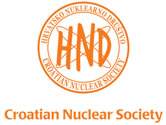
11th INTERNATIONAL CONFERENCE
OF THE
Croatian Nuclear Society
(Former Nuclear option in countries
with small and medium electricity grids)
ZADAR, CROATIA
5–8 JUNE 2016
The Croatian Nuclear Society (HND), in cooperation with the International Atomic Energy Agency (IAEA), the European Nuclear Society (ENS), and the Croatian State Office for Radiological and Nuclear Safety (DZRNS) will organise the 11th edition of the International Conference (former Nuclear Option in Countries with Small and Medium Electricity Grids). The Conference will be held at Hotel Kolovare, in Zadar, Croatia, from June 5th to June 8th 2016.
In view of good response and success of the previous Croatian Nuclear Society conferences, devoted to the needs and interests of countries with small or medium nuclear systems and electricity grids, the 11th International Conference in Zadar will serve the same general purpose, concentrating on the topics which attracted the most interest in previous conferences. It is the follow up conference intended to save the needs and interests at this important and growing group of countries. The Conference will consider the nuclear option from the point of view of the national energy strategy, resources, costs, technological, organisational and educational requirements, and environmental advantages. It will also focus on matters related to operational safety, fuel cycle, waste management, and decommissioning.
The important goal of the Conference is to promote regional co-operation and exchange of experience in use of nuclear power and fuel cycle facilities among small or medium-sized countries with an interest in the nuclear option.
For further information about the Conference, please refer to the attached file First Announcement and Call for Papers or visit the web site: HND Conference Website.
Follow the key dates and deadlines:
Abstract Submission: 15 Jan 2016
Abstract Notification: 15 Feb 2016
Full Paper Submission: 1 Apr 2016
Important Links:
HND Conference Website
Conference Management Tool
![]() download Call for Papers flyer
download Call for Papers flyer
http://www.euronuclear.org/e-news/e-news-50/finland.htm

The construction of the first reactors in Finland started early 1970s. The first reactor (Loviisa 1) started operation in 1977 and the second one (Olkiluoto 1) in 1978. The second units in Loviisa and Olkiluoto followed in 1981 and 1980, respectively.
The Finnish power companies tried to get permission to build a new reactor unit in 1980s and 1990s. These attempts failed in 1980s (due to Chernobyl) and 1990s (no political support) but finally succeeded in 2002, when TVO got a positive decision from the parliament for Olkiluoto 3. Construction of OL3 started in 2005 when TVO obtained the construction license. The following license to build a new nuclear power plant in Finland went to Fennovoima's Hanhikivi site which received political acceptance in 2010 and a construction license application was submitted in 2015.
In the radioactive waste management area, repositories for low and intermediate level waste were built in 1990's at the NPP sites in Loviisa and Olkiluoto. They have been operated by the power companies ever since. Spent fuel disposal project started in 1980s by TVO. Fortum joined the project after the export of spent fuel from Loviisa NPP to Russia was terminated in 1990s. A joint company called Posiva was established by TVO and Fortum in 1995. A site for spent fuel repository was selected around 2000 and a construction license application was filed in 2012. The construction license for spent fuel repository was granted in November 2015. The spent fuel repository is expected to start operation in early 2020s.
The main research organization in Finland is VTT Technical Research Centre of Finland, which also operated the only research reactor in Finland (FiR1). FiR1 was closed a couple of years ago and it is now in the decommissioning process. A new Nuclear Technology House is under construction at VTT, which will improve the laboratory capabilities of VTT's nuclear research teams e.g. in material research area.
The main Universities providing education in nuclear engineering are Aalto University in Espoo (e.g. in technical physics), Helsinki University (e.g. in radiochemistry) and Lappeenranta University (e.g. nuclear engineering and experimental reactor thermal hydraulics).
The development of the necessary knowledge base for utilities, the regulator, universities and research centers was a challenge when the nuclear program started in Finland in 1970s. Similar challenges have been faced during the last years, due to the need for new experts in the new NPP projects and due to the retirements of the experts who started their career in 1970s. To fill the gap a dedicated nuclear course has been organized to support the education of new experts into the nuclear field. More than ten courses (about 5 weeks of training) have been organized (one course per year) with 60-70 participants in each course.
Due to limited resources the international co-operation e.g. with reactor vendors (e.g. ABB Atom in Sweden), international organizations (IAEA, OECD) and international waste management organizations (e.g. with SKB) has been vital for the development of nuclear expertise in Finland. Today Posiva's spent fuel disposal project is moving from research phase to construction phase. The spent fuel encapsulation and final disposal facility should start operation early 2020s. The main challenge of the project is the fact that it is the first of its kind facility in the world which is a challenge both for the operator Posiva and for the regulator.
Loviisa NPP units have an operating license valid until 2027 (Loviisa 1) and 2030 (Loviisa 2). Olkiluoto 1 and 2 plants have operating license valid until 2018. According to TVO Olkiluoto 3 will apply for operating license early 2016. There is no political pressure to close the reactors. Hence, the utilities may apply for new operating licenses, if they consider it economical.
The challenges of nuclear power production in Finland include e.g. the low power prices in Nordic countries, which have led to decisions to close the oldest reactor units in Sweden. Updating the oldest reactors to meet the latest safety standards, the availability of the spare parts for the oldest reactors, and motivation of personnel when approaching the time for closing and decommissioning of the oldest reactors will be a challenge in the future.
http://www.euronuclear.org/e-news/e-news-50/hungary.htm

1974: start of construction of units 1 and 2 of Paks NPP (VVER-440)

Fig.1. Constructions works at the Paks NPP
1975: establishment of the Atomic Energy Research Institute
1976: start of operation of Radioactive Waste Treatment and Disposal Facility at Püspökszilágy
1979: start of construction of units 3 and 4 of Paks NPP (VVER-440).
1980: acceptance of first atomic law
1982: connection to grid of unit 1 of Paks NPP
1984: connection to grid of unit 2 of Paks NPP
1986: connection to grid of unit 3 of Paks NPP
1987: connection to grid of unit 4 of Paks NPP
1987: start of operation of simulator centre at the Paks NPP
1991: establishment of the Hungarian Atomic Energy Authority
1991: formation of the Hungarian Nuclear Society
1993: completion of the reconstruction of the Budapest Research Reactor
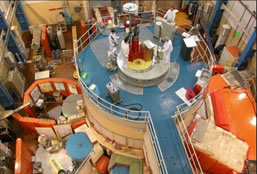
Fig. 2. Budapest Research Reactor
1994: reassessment of the safety of Paks NPP in the framework of the AGNES project
1997: acceptance of second atomic law
1997: start of operation of Interim Spent Fuel Storage Facility
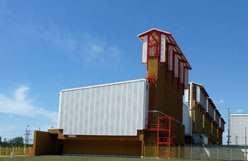
Fig. 3. Interim Spent Fuel Storage Facility
2009: completion of power uprate to 108% on all four units of Paks NPP
2012: National Radioactive Waste Repository opened at Bátaapáti

Fig. 4. National Radioactive Waste Repository
2012: approval of lifetime extension for unit 1 of Paks NPP
2014: decision on building two VVER-1200 units on the site of Paks NPP
2014: approval of lifetime extension for unit 2 of Paks NPP
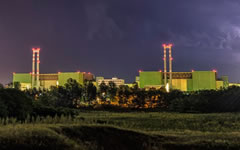
Fig. 5. View of the Paks NPP
The first reactor at the Paks NPP was put into operation in 1982, the second in 1984, the following units in 1986 and 1987. The reconstruction of the research reactor at the Centre for Energy Research (CER) of the Hungarian Academy of Science was done in 2009 -- the HEU fuel elements have been replaced with LEU fuel rods, the HEU fuel elements were transported to Russia. The main topics for research and developments at the CER are:
Nuclear safety research,
New reactor systems,
Man-machine interface and applications,
Dosimetry, health physics, environmental analysis,
Nuclear safety analysis, safety and security issues,
Radiation chemistry and its applications,
Nuclear reactions and methods for analysis,
Surface chemistry and catalysis
The training reactor at the Institute of Nuclear Techniques (INT) of the Budapest University of Technology and Economics (BME) has been in operation since 1971. INT holds lectures and laboratories for the BSc, MSc and Ph.D. students graduated in the field of "Nuclear Energy", "Nuclear Techniques" "Medical Physics" and "Nuclear Energy" The institute organises regularly the postgraduate continuing education program "Reactor techniques", organises and participates in the international "Eugene Wigner Course for Reactor Physics Experiments" ENEN exchange course (in English).
The medical application of nuclear technology has become widespread in Hungary: X-ray and isotope diagnostics, monitoring examinations, radiotherapy by accelerators and sealed radioactive sources, and isotope diagnostics and therapy by radioactively labeled compounds. For human and environmental safety purposes the Health Environmental Radiological Monitoring Network and Authority Nuclear Safety Monitoring Network were established. The data of the national monitoring networks is collected and processed by the National Radiological Monitoring Network.
The challenges we faced in the past are related to several topics. AGNES (Advanced General Safety and New Evaluation of Safety) project was started in 1991. The goal of the project was to evaluate to what extent Paks NPP satisfied the current international safety expectations and to help in determining the priorities for safety enhancement and upgrading measures. The project was completed in 1994. In this framework, the seismic resistance of the NPP was substantially improved. Also, a Central Nuclear Financial Fund was established as of the 1st of January 1998 by the Act on Atomic Energy and the executive orders thereof, with the purpose of financing the disposal of radioactive wastes, the interim storage, and final disposal of spent nuclear fuels and the decommissioning and dismantling of nuclear facilities.
Three of the most important technical tasks for the coming years: extension of a new disposal facility for the low- and intermediate-level wastes (L/ILW), and also of the existing Interim Spent Fuel Storage (ISFS), and the selection of a site for the long-lived high level waste (HLW) repository.
Also, we have to consider the power uprate of NPP Paks done in the period 2006-2009: the original 440MW capacity was increased to 500 MW for each of the 4 reactors. The plant’s lifetime extension program was started in 2007. The lifetime extension of Unit 1 was approved in 2012, of Unit 2 in 2013. The application for Unit 3 was submitted by the end of last year, and for Unit 4 it will be submitted by the end of this year.
Furthermore, the Teller project was initiated in 2007 aiming at the preparation for the construction of 2 more reactor blocks at the Paks NPP site. The project now is running under name of Lévai-project. The consequences of the 2003 event connected with the overheating of some used fuel assemblies during a cleaning process -- assessed level 3 on the IAEA INES scale -- were successfully eliminated.
Hungary is committed to using nuclear energy for electricity production in the future. We are in the licensing phase of two new build VVER-1200 design nuclear power reactors. Hungary is looking to maintain the share of nuclear power in the energy mix.
The European Commission initiated two investigations on the issue of Paks II new build project: on procurement and state aid matters. To answer the ECs remarks properly and to get a green signal for the new NPP construction from the EC is the No. 1 challenge for the nearest future. The construction of the new NPP (two Russian reactor blocks 1200 MW each) is the largest construction work that has been performed in Hungary in recent decades. To build the plant timely is a key factor of the economy of the plant due to the huge investment costs (discount rate effect). The fate of the new build project is crucial for the future of the nuclear industry in Hungary.
If, and when, renewables become economically competitive, nuclear will have a hard time staying viable, both from an economic and political standpoint. However, this scenario seems – at this time – to be far off in the future.
We are also looking into a solution of the disposal of spent fuel which should be found as soon as possible to demonstrate to the public that the nuclear industry is capable of dealing with the radiactive waste management issue safely and economically. As an alternative, the transport of the fuel back to Russia for reprocessing should be considered. Concerning the project for a National Radioactive Waste Repository, the main task for the future is to provide disposal capacity for the low and intermediate level waste generated at Paks NPP. On the basis of the optimized disposal concept, a reinforced concrete vault shall be constructed in the 2nd disposal chamber.
The main challenge in the field of radioactive waste management is to implement the deep geological repository, which serves as a final solution for the disposal of the high level and/or long-lived wastes. Hungary is in the very beginning of this project. A surface based geological investigation is ongoing in the Boda Claystone Formation aiming to narrow down the investigation area and in the mid-term (till 2030) to designate the location of the Underground Research Laboratory.
Currently the spent fuel is safely stored in the Interim Spent Fuel Storage Facility, which is a Modular Vault Dry Storage system. This facility can be extended modularly in parallel with the spent fuel generation at Paks NPP. Beside the regular expansion, the originally planned 50-year lifetime of the facility has to be prolonged with at least an additional 30 years. A significant research and development program has to be carried out in the mid-term to justify the lifetime extension.
http://www.euronuclear.org/e-news/e-news-50/netherlands.htm

The Netherlands is a country with a relatively small nuclear energy programme, but since two decades a considerable activity on development and production of medical isotopes has existed in the country. Nuclear research is conducted mostly at NRG, operator of the HFR, and at the Delft University of Technology.
.jpg)
Due to its large gas reserves, the number of nuclear power plants remained at only 2 – the permanently shut down 60-megawatt BWR at Dodewaard and the operational 482-megawatt PWR at Borssele. At the same time the enrichment industry has been developing successfully and the HFR is being operated, starting from purely nuclear energy and science applications to primarily medical production.
Public research funding was cut severely, forcing the Reactor Centre Netherlands to convert, now in the form of NRG, from a research-only oriented organization working on mostly nuclear technology applications related to energy conversion, towards a business-driven organization working on consultancy, commercial business and research/innovation in the areas of health, energy and rad-waste.
.jpg)
There were significant societal discussions on nuclear power in the 1980s, which later on lost the public’s interest. The smaller nuclear plant Dodewaard was closed in 1997 and put into safe shut down. The larger plant Borssele was almost shut down in 2004 but survived due to a legal challenge by the personnel, united in a foundation for maintaining the plant. Later on the plant’s operational period was extended to 2033, provided it will remain in the top 25% of best performing plants in the world.
The challenges faced in the past concerned mostly making ageing infrastructure compliant with up-to-date licensing requirements as well as the reduction of government funding for nuclear research of about 80-90% in the early 1990s, to 20-30% in 2010-2015.
Currently there are no plans for a second NPP in the Netherlands. However, the operation of the coal fired power stations in the Netherlands is under pressure because of the climate discussion, so there may be room for nuclear initiatives for replacement in a few years. Development of the electricity market is most important here, not so much public opinion.
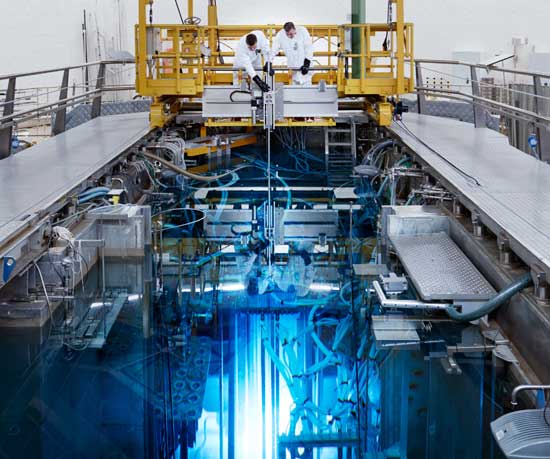
The Netherlands has a nuclear research infrastructure for both experimental and computational work on isotope developments, fission/fusion applications and radwaste handling. The ageing HFR is foreseen to be replaced by the Pallas reactor in 2024, with the government funding the preparation phase and private investors funding the actual construction.
One of the biggest challenges for nuclear development is maintaining the capacity and competence-base. The role of nuclear in the energy mix is gradually reducing in Western Europe, and the growth of medical isotopes is stabilizing in Western countries. This requires a renewed target for nuclear development in a shrinking market. In that respect, the application of the principles of Full Cost Recovery and a harmonized European approach of funding nuclear development and (the reduction of) subsidizing nuclear business.
.jpg)
Although the Dutch nuclear energy programme may be small, responsibility is taken on all its aspects, including long term safe operation of nuclear plants and other facilities, and management of all nuclear waste on a national interim storage facility. New build driven by the need for medical isotope production is in active preparation, and the option for new nuclear power plants is open.
http://www.euronuclear.org/e-news/e-news-50/poland.htm

Together with ENS, which is celebrating its 40th anniversary, the Polish Nuclear Society will celebrate the 25th anniversary of its official establishment. The concept of the establishment of PTN was born in the spring of 1990. At that time there were stormy discussions on the desirability of the nuclear power plant being built at Żarnowiec. In this situation arose the concept of using the lessons of other countries which had been successful in disseminating knowledge on nuclear technology and developing nuclear power without much difficulty.
A group of scientists sent a letter to the Secretary General of the European Nuclear Society (ENS), with headquarters in Geneva, requesting information on the possibilities of cooperation with the bringing together of dozens of nuclear science companies from across the world. Then, after an initial consultation in April, the then President of the National Atomic Energy Agency proposed the accession of Poland to ENS. The condition, however, was to create an organization operating outside the structure of the government and pro-development science and nuclear techniques. In July, they developed a "Declaration to create a Nuclear Society" and began the appropriate information campaign. The founding meeting was held at the Institute of Thermal Technology (ITC), Technical University of Warsaw in two stages: 14 February and 16 March 1991. During the meetings, they voted on and adopted the statutes. On 9 May 1991, the Department of Civil VII Regional Court for the capital city of Warsaw, in the presence of several founding members, the company was established. On 26 June 1991, the ITC Warsaw University of Technology took place on 1st General Assembly of the PTN, convened by the 145 members of the Founding enterprises. The official logo of the organization is “PTN” in Polish (Polskie Towarzystwo Nukleoniczne).
It should also be recalled that we have begun preparations for the 150th anniversary of the birth of Maria Skłodowska - Curie. The anniversary falls in November 2017. Currently, the house where the winner of two Nobel Prizes was born is being renovated. It now houses the Museum of Maria Skłodowska - Curie. We hope also that the organizations affiliated to ENS will not forget this anniversary.
.jpg) |
.jpg) |
The photographs shown a medal Polish Chemical Society. The headquarters of this organization is the Museum of the Maria Skłodowska Curie. This medal in November last year received Secretary General of the Polish Nuclear Society (Dr. Wojciech Głuszewski). A similar medal was also President Lech Walesa, honorary patron of the Congress of the Polish chemist.
.jpg)
Photo. 3. President Lech Walesa in the 3rd row. Secretary of PTN third from the right in the second row.
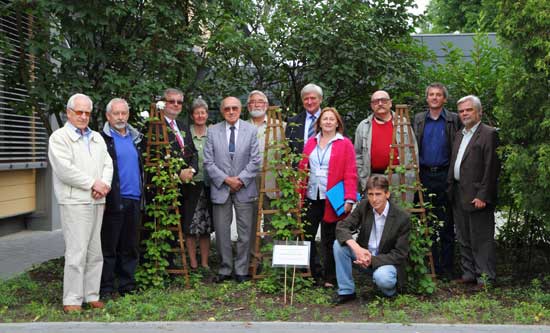
Photo. 4. Several members of the Board of the Polish Nuclear Society against a new variety of clematis, which received the name of Maria Skłodowska - Curie.
http://www.euronuclear.org/e-news/e-news-50/romania.htm

In 2015, Romania celebrated 60 years of nuclear activity in the country.
|
First nuclear facilities in Romania were a VVRS research reactor (1957) and U120 cyclotron (1959), both Soviet Union made. Today the VVRS reactor is under decommissioning at Horia Hulubei National Institute of Physics and Nuclear Engineering-IFIN HH. From the 1960s, the Romanian scientists managing research in physics encouraged researchers to become involved in the development of the applications of nuclear energy in industry, medicine and in other fields of social life of society. |
Today, IFIN-HH constructs the Extreme Light Infrastructure Nuclear Physics facility (ELI-NP) one of the three pillars of future European ELI which will create a new European laboratory to consistently investigate a very broad range of science domains, from new fields of fundamental physics, new nuclear physics and astrophysics topics, to applications in material science, life sciences and nuclear materials management. |
|
From 1957, Romania participated as a founding country, to all major IAEA initiatives for peaceful use of nuclear energy. Fundamental and applied research from the 1960s in line with world approach to peaceful use of nuclear energy at that time allowed accumulation of proper information that supported the country decision for embarking nuclear power.
The first national nuclear power program was approved in 1968. From the beginning, Romania’s objective was for total energy security. The final option was for CANDU- PHWR reactor type. This option was supported by existing uranium resources and accessible heavy water technology due to established research capacity and tradition in oil and chemistry industry.
|
The first major contract for starting the works on the Cernavoda site in order to construct an NPP with a CANDU design started in 1979. Today, Cernavoda NPP operates Unit 1 (operational since 1996) and Unit 2 (operational since 2007). |
Within the last 26 years, Romania developed a robust national nuclear system supported by its main components: a legislative and regulatory framework, an independent nuclear safety regulator, a diversified and appreciated research infrastructure supporting both nuclear applications and non-nuclear applications of nuclear energy, and a large spectrum of nuclear license holders using nuclear technology, starting from NPP and nuclear fuel fabrication plant and continuing with the industry, hospitals or medicine. In depth analysis would indicate that there were registered gaps and time delays in finalizing some projects promoting nuclear activities. Romania has welcomed IAEA (starting from the 1960s) and European Commission (during the pre-accession period and when it became an EU Member State in 2007) support in channeling optimum project solutions.
The Institute for Nuclear Research in Pitesti (ICN) was established in 1971. ICN Pitesti had and still has as its main task the maintenance and development of the scientific and technological support for the national nuclear energy program, a vital component in ensuring the sustainable, clean and safe energy for Romania's citizens. The Institute ensures the operation, development and use of its infrastructure (it operates a TRIGA research reactor, examination and testing laboratories, radioactive waste treatment facility, etc.) required to carry-out the research and development programs, education and training of specialists, as well as a sustained international cooperation. ICN promotes the development and application of nuclear technologies in medicine,
|
industry and agriculture adding an important contribution to increasing the citizens' quality of life. ICN Pitesti is a part of the European research projects for Generation IV power reactors (e.g. the Alfred project). |
The Centre of Technology and Engineering for Nuclear Projects CITON has gained and steadily enlarged its experience in project engineering services, design and construction management in the electric power domain starting in the 1970s. CITON performs design and engineering work and assures technical assistance and engineering support for construction – installation, commissioning and operation and maintenance of Cernavoda NPP and other nuclear facilities. CITON as a full-service engineering company and can assist customers with all phases of project implementation including development support and EPC interconnection.
The declarations of the Romanian Government that it supports the continuing development of nuclear activities in Romania are important. Romania has ratified all international conventions on nuclear activities and transposed new European Directives on nuclear safety and spent fuel and radioactive waste management.
A decision making process for 2 new CANDU units on the Cernavoda NPP site is currently supported by the Romanian Government.
|
Romania's nuclear energy program foresees for the safe and competitive operation of Units 1 and 2 of Cernavoda NPP, the completion of Units 3 and 4 Cernavoda NPP, the promotion on the medium and long term of Generation IV advanced reactors, as well as the safe storage and disposal of spent fuel and of radioactive waste. |
The challenges in the development of nuclear activities in Romania, particularly nuclear power development, might be common with those that would be faced by the development of nuclear activities in the European Union. The influence of social, societal or regulating factors might become crucial in this development. The Romanian Nuclear Energy Association (AREN) congratulates the European Nuclear Society (ENS) with the occasion of 40 years of activity and expresses its gratitude on its effective role in promoting the advancement of nuclear activities and supporting its members by a varied portfolio of activities for understanding the challenges and communicating this advancement to the national stakeholders.
http://www.euronuclear.org/e-news/e-news-50/slovakia.htm

The nuclear power industry in Slovakia and in the Czech Republic was built on a basis of the integrated nuclear program of the former Czechoslovakia. So, until 1993, the Czech and Slovak Republics had a common power system. Both countries were building pressurized water reactors (PWRs) together (at Jaslovské Bohunice, Dukovany, Temelín, and Mochovce).
The era of the nuclear power industry began in the former Czechoslovakia in August 1958 by the construction of the prototype A1 Nuclear Power Plant in Jaslovské Bohunice, which was equipped with a KS 150 heavy water type reactor and used natural uranium as a fuel source. It was cooled by gaseous CO2. The Unit was in operation since October 1972 till February 1977, when it was permanently shut down. At present, the A1 NPP is undergoing the Decommissioning Stage II Program.

The construction of V1 Nuclear Power Plant with VVER 440/V 230 type reactors was launched in Jaslovské Bohunice on 24 April, 1972. Unit 1 of V1 NPP was put into trial operation in December 1978 and Unit 2 in March 1980. As a result from a condition under the EU-accession agreement, Unit 1 of V1 NPP was definitively shut down on 31 December 2006 and Unit 2 – on 31 December 2008. At present, V1 NPP is undergoing the Decommissioning Stage I Program.

During the course of the construction of V1 NPP, due to an assumed deficit in the power balance of Slovakia, it was decided to construct V2 NPP as Units 3 and 4 of the Bohunice power plant. The construction of V2 Nuclear Power Plant with advanced VVER 440/V 213 reactors began in 1976. Both units have been operated safely and reliably since then.
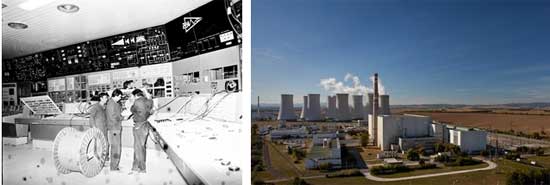
The construction of Mochovce NPP started in June in 1981. The NPP project was planned as a four-unit plant. Unit 1 began to supply electricity to the power grid in the summer of 1998 and Unit 2 - two years later. Both units are equipped with pressurized water reactors of VVER 440/V-213 type. Construction of Units 3 and 4 was suspended in 1992 and re-started in November 2008. Beginning of their operation is expected in 2017 and 2018 respectively.

Nuclear research was part of the development of nuclear power in Slovakia. Formed from the original R&D department at the Bohunice site, the Nuclear Power Plant research institute VUJE was established in 1977. Today, VUJE a. s., engineering company performs design, supply, implementation, research and training activities, particularly in the field of nuclear and conventional power generation and is an internationally recognised institution in nuclear research.
Slovak Universities and technical schools have developed programmes of nuclear education and various aspects for the peaceful use of nuclear energy, including fusion.
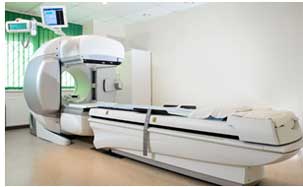 Nuclear medicine is a medical specialty that uses radioisotopes for diagnosing and treating diseases. Its origin in Slovakia can be dated in the mid-1950s. Slovakia gradually created 13 departments, not only in most major hospitals, but in individual health centers and private health facilities as well. Nuclear medicine is a medical field training specialists not only for doctors, but also for other professions in the health sector. Nuclear medicine diagnostic section enables imaging, but especially non-invasive examination methods. Today, clinics, centres or departments of nuclear medicine, exist in each larger town as highly specialized institutions in order to develop the most advanced diagnostic methods of medical imaging and laboratory procedures of nuclear and molecular medicine, as well as for the treatment of diseases using open sources.
Nuclear medicine is a medical specialty that uses radioisotopes for diagnosing and treating diseases. Its origin in Slovakia can be dated in the mid-1950s. Slovakia gradually created 13 departments, not only in most major hospitals, but in individual health centers and private health facilities as well. Nuclear medicine is a medical field training specialists not only for doctors, but also for other professions in the health sector. Nuclear medicine diagnostic section enables imaging, but especially non-invasive examination methods. Today, clinics, centres or departments of nuclear medicine, exist in each larger town as highly specialized institutions in order to develop the most advanced diagnostic methods of medical imaging and laboratory procedures of nuclear and molecular medicine, as well as for the treatment of diseases using open sources.
Nuclear development, however, has not been always straightforward and smooth. In early times nuclear experience was accumulated step-by-step, many times learning from our own mistakes. Technical problems were being solved on the go, at that time shrouded in an environment of secrecy. Nuclear safety was in the cradle and experience was substituted by enthusiasm, safety culture was unknown… All these factors contributed to persistent technical problems and eventually lead to two accidents at the first nuclear power plant A1 after which the plant was permanently shut down.
Construction of all VVER units in Czechoslovakia was strongly opposed by Austria and required a lot of explaining, arguing and diplomacy to put the units into operation despite the fact that the public in Slovakia is generally positive towards nuclear energy. In the EU accession process Slovakia was pushed to close its two oldest VVER units without any technical substantiation, although the units had been upgraded to the internationally accepted safety level.
After the break-up of Czechoslovakia, the Slovak republic needed to replace all federal institutions, including the nuclear regulation authority on the national level. This challenge was coped with efficiently, assuring uninterrupted smooth and safe operation of all NPPs.
The construction of Mochovce NPP units was challenged by strong opposition from Austria and later by organizational and market changes including new majority owner of the operating company, a decrease in electricity demand and a lack of funding. Just two units out of four were completed and construction of third and fourth units was suspended and resumed several years later. Their construction is still going on with anticipated completion in 2017 and 2018 respectively.
In spite of those challenges and changing market conditions, we can proudly state that the Slovak nuclear power sector is mature, providing safe and reliable baseload carbon-free electricity. In the light of environmental challenges and conclusions of the Paris COP21 climate change conference, nuclear will have to be a part of the Slovak energy mix for the coming decades and with the closing of existing nuclear power plants they will be replaced by new ones, using the best technology available.
Slovakia, together with the Visegrad partners - the Czech Republic, Hungary and Poland - joined forces in designing and eventually building a demonstration reactor of the gas-cooled fast neutron type called ALLEGRO. This project will be a driver of nuclear and material research in participating countries and a great opportunity for a new generation of young scientists and technicians to put their hands on cutting edge science and technology.
http://www.euronuclear.org/e-news/e-news-50/sne-news.htm

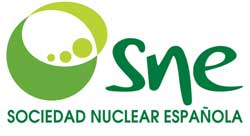
In 1951, the Junta de Energía Nuclear (JEN) was created to assume the main technological, training and administrative functions in the nuclear field. Over the years, it began ceding its responsibilities: those corresponding to the front-end of the nuclear fuel cycle to the Empresa Nacional de Uranio (ENUSA), which was created in 1972, those related to nuclear safety and radiological protection to the Nuclear Safety Council (CSN) in 1980, and in 1984 those involving radioactive waste management and dismantling of nuclear facilities to the Empresa Nacional de Residuos Radiactivos (ENRESA), which took over the waste storage facility of El Cabril that was owned by the JEN.
The creation of the Spanish Nuclear Society in 1974 coincided with the beginning of the fastest period of expansion of nuclear energy in Spain. The National Energy Plan approved in January of 1975 tried to react to the oil crisis of 1973 by considerably reducing its consumption. For that purpose, the aim was to give growing importance to nuclear energy, which was to go from supplying 7.1% of electric power production in 1975 to 56% in 1985, with plans to build more than 20 new nuclear units, although most of them never obtained the nuclear site permit.
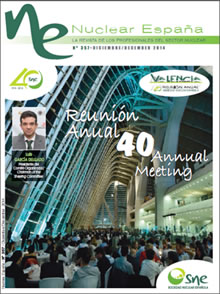 |
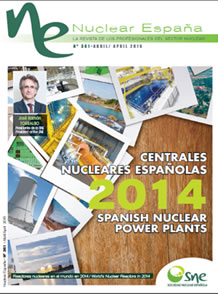 |
By 1975 three nuclear power plants, classified as first generation, were in operation: José Cabrera nuclear power plant, Vandellós-I nuclear power plant and Sta. M. de Garoña nuclear power plant, whose design, construction and startup were undertaken with the “turnkey” method with a national share of around 40%.
Between 1973 and 1975, the construction licenses of the second generation of nuclear power plants were granted: Almaraz-I and –II nuclear power plant, Lemóniz-I and –II nuclear power plant, Ascó-I and –II nuclear power plant and Cofrentes nuclear power plant. The supplier of the Nuclear Steam Supply System and the Turbine-Generator set for the first six was Westinghouse, and General Electric for the latter.
The construction licenses for another five units were granted in 1979-80: Vandellós-II nuclear power plant, Valdecaballeros-I and –II nuclear power plant and Trillo-I and –II nuclear power plant. For these plants, the Spanish engineering firms took over the project management and eventually reached levels approaching 85% of the total investment in the last nuclear projects.
However, the National Energy Plan of 1983, which limited installed nuclear power to 7,600 MWe, marked the end of new nuclear projects in Spain by implementing a moratorium on five of the units that were under construction (Lemóniz NPP units I and II, Valdecaballeros NPP units I and II and Trillo NPP unit II). These units were later brought to a definitive halt in 1994 with the enactment of the national electric power system planning and development act.
This decision had a very negative impact on the nuclear industry which, without having its own nuclear technology, had achieved a high technological level in the fields of engineering, service provision, equipment manufacturing, etc. Furthermore, the lowered expectations led to a loss of interest in this sector, which was reflected by the departure of numerous professionals who had trained and gained experience over those years, as well as by the drastic reduction in the number of students enrolled in the nuclear specialties of the technical colleges.
In 1984, the Spanish Parliament decided to create the Empresa Nacional de Residuos Radiactivos (ENRESA) as a non-profit public entity responsible for the inventory, removal, transport, processing and storage of radioactive wastes, as well as the dismantling of nuclear and radioactive facilities, based on the principles of minimization and safety.
A few years later, the Chernobyl accident of 1986 would result in the cessation of construction of new nuclear power plants in the countries of the West.
In 1988, a cost recognition system, known as the Stable Legal Framework, was established to determine the tariff of the management enterprises of the electric power supply service. Subsequently, the Electric Power Sector Act of 1997 gave way to a liberalized market in which the revenue of the generators was fixed by this market, thus ceasing to be a regulated remuneration. This liberalization posed a challenge to the Spanish nuclear sector because of the need to assure that the nuclear power plants would be operated under conditions of utmost safety, regardless of the competitive context of the market in which they operate.
Spanish engineering in the nuclear field had to evolve since the industry concentrated on perfecting operation of the fleet with very favorable results. The improvements in reliability and availability, as well as the power uprates, the improvements made in the fuel cycle and the possibility of long-term operation of the plants for up to 60 years and more, all helped to improve the competitiveness of these facilities.
The subsequent accident in Fukushima in 2011 was a new setback for nuclear energy, as it created uncertainties about its future just at a time when there was renewed interest in this source of energy.
After the JEN disappeared, the Centro de Investigaciones Energéticas, Medioambientales y Tecnológicas (CIEMAT) was created in 1986 as a national reference center for energy and environmental research, including in the nuclear field.
In this field of research, the Electrotechnical Research Plan was implemented in 1983 to promote national electrical technology, and in 1999 the advisability of coordinating these efforts nationwide was considered to jointly undertake projects of common interest and be able to take a single national position for participation in international projects, thus optimizing the available resources. With this objective in mind, the Ministry of Industry and Energy, in collaboration with the CSN, the electric power sector and the main agents involved, promoted the creation of the CEIDEN. In 2007 this would become the CIEDEN technology platform for the purpose of extending participation to more entities with an interest in nuclear R&D. At present it has nearly one hundred public and private members, which represent the large majority of the players in this field in Spain.
With regard to regulatory evolution, the Nuclear Energy Act of 1964, which focused on fostering the peaceful uses of nuclear energy, and eight years later the publication of the nuclear and radioactive facilities regulation (RINR), which implements the authorization regime provided in the Act, provided the legal and administrative basis for development of the nuclear program.
In 1980, an essential step was taken with enactment of the law creating the CSN as a public-law entity independent of the State’s Central Administration and the only entity with powers in matters of nuclear safety and radiological protection. Its mission is to assess and control the design, construction and operation of nuclear and radioactive facilities based on the model of the U.S. Nuclear Regulatory Commission.
Over the years, new regulations and revisions have been approved, both at the legal and regulatory levels, basically for the purpose of accommodating technological advances and the national and international experience gained, as well as the need to include the commitments acquired by the Spanish State in the international arena.
The Fukushima accident has made a mark on the activity of the nuclear sector over these last few years.
In the framework of the EU, our country, just as the rest of the member states, chose to adopt the agreed on strategy of performing stress tests. These tests have highlighted the high safety conditions under which the Spanish nuclear power plants operate although, just as in the rest of the EU plants, improvements have been identified that are in the process of being implemented and that will enhance the safety of the plants. This should help to restore the trust lost after the accident.
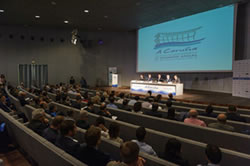 |
 |
The nuclear share in national electric power production is still very significant – around 20% - thus ranking Spain as the fourth largest nuclear energy producer in the EU and the eighth in the OECD. In recent years, an intense process of renewal of the Spanish nuclear power plants’ operating licenses has been taking place.
Spanish engineering in the nuclear field has remained active in several areas:
Operating support to the fleet in operation
Participation in the design of 3rd generation plants
Participation in the European assistance program to improve the safety of the nuclear power plants in the former Soviet Union
Different kinds of projects in waste treatment and in the second part of the fuel cycle
Participation in the nuclear fusion ITER project
Participation in the design of the 4th generation of nuclear reactors
Participation in the launch phases of new nuclear power plant projects
Technological projects in the nuclear field
Information systems
Looking to the future, nuclear energy will undoubtedly continue to be a strategic energy supply option available to those countries that want it, particularly if the aim is to have a low carbon economy.
Spain has a comprehensive regulatory framework that meets the most demanding international criteria in this field and a regulatory body that has a highly qualified, experienced technical corps.
Furthermore, with the low- and intermediate-level radioactive waste storage facility in El Cabril and the Centralized Temporary Storage facility, the startup of which will put an end to a long process that began in 2006, Spain will be in position to guarantee the safe management of the country’s spent fuel and radioactive wastes in the decades to come.
http://www.euronuclear.org/e-news/e-news-50/sweden.htm


The Swedish nuclear power programme began with the commissioning of light water reactors which were brought into operation between 1972 and 1985. Together they produced about half of the Swedish electricity demand – currently about 40%. Almost all the rest was provided by hydro power stations currently supported by wind power units, making the Swedish electricity power production almost completely free of fossil fuels. This was also one of the primary aims of the nuclear power implementation and the rate of adding new plants. The Swedish program is by far the world’s fastest program ever to establish CO2-free electricity production.
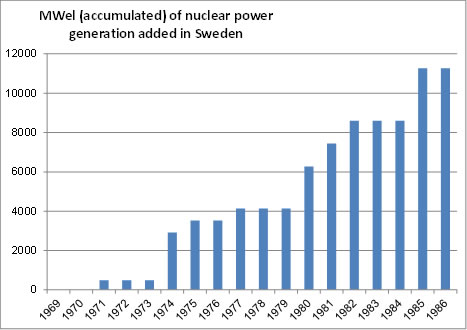
The figure to the above shows the power added to the grid by the nuclear power units. (Note: the power has since the original startup been increased in all but the first unit).
The first figure on the next page shows how these units were constructed and taken into operation. The program as a whole must be considered a success considering the short construction times. As explained later the results were achieved despite considerable political turmoil in an era when safety requirements were developing very quickly – the regulatory environment was volatile to say the least.
The accumulated energy produced in the Swedish nuclear power plants reached more than 2100 TWh by the end of 2014. This is more than 15 times the yearly electric energy consumption in Sweden. The second figure on the next page shows the accumulated electric energy delivered by the Swedish units.
There was essentially a national consensus on building nuclear power plants until the change in government in 1976. An anti-nuclear government lead by the Center Party took over with the aim to stop further increase in the use of nuclear power. Agreement could however not be reached and the only result was a new law (1977) requiring the operators/licensees to show means of taking care of the irradiated fuel and highly radioactive waste in order to be allowed to load fuel into the reactors. According to the law one could use reprocessing and then store the waste or store the irradiated fuel in a final depository. This law (Law on Conditions to Load Fuel – Villkorslagen in Swedish) was one reason for the power companies to establish SKB (Swedish Nuclear Fuel and Waste Management Company) to organize, and establish means and facilities for the handling of waste and irradiated fuel from the Swedish nuclear program. SKB established the KBS-1 method for use of reprocessing and then storing the waste, and the KBS-2 (later developed to KBS-3) method of storing the irradiated fuel without reprocessing. The Act on Nuclear Activities established in 1984 eliminated the conditional law. A general consensus emerged on not using reprocessing as a means to reduce the storage requirements. The KBS-3 method was endorsed as the future means. Currently, Swedish authorities are reviewing an application from SKB regarding a final repository for high-level nuclear waste based on the KBS-3 method. Once approved Sweden will probably be the second country (next Finland) to take a final repository into operation.
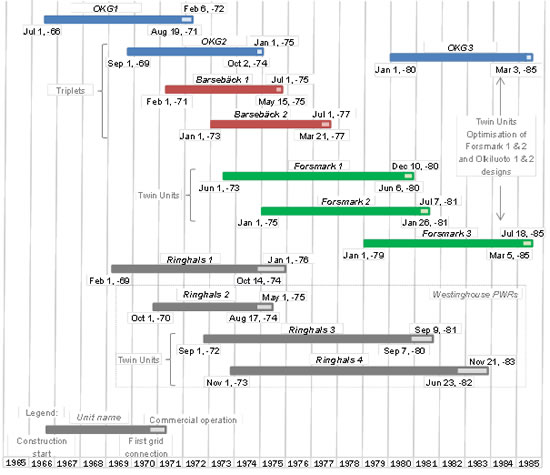
Above - Construction of the 12 Swedish Nuclear Power Units. Below – Energy delivered by the Units.
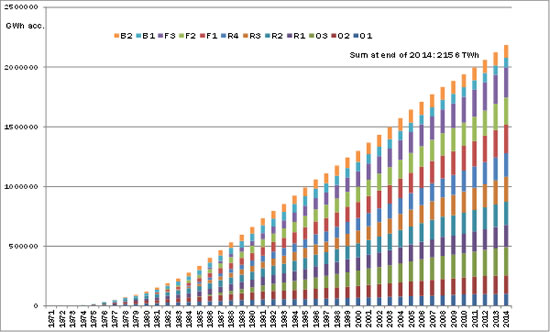
Following the Three Mile Island accident in 1979, the government decided to have a national referendum on the use of nuclear power. Voters could choose among three alternatives. All alternatives included that nuclear power should be abandoned. Alternative 1 stated that this should be done after using those already built and in the process of being built, when suitable alternatives were available. Alternative 2 was essentially identical, but included also some statements on ensuring safety and avoiding the use of oil and coal. It also claimed that excessive profits from hydro power supply should be heavily taxed. Alternative 3 stated that only those in operation should be used for a maximum of 10 years and those under construction should be stopped. Together, alternatives 1 and 2 draw about 60% of the votes. More than 75% of those who were allowed to vote did so. Following the referendum the parliament decided that all units should be stopped latest 2010, when the last units to be built (OKG3 and Forsmark 3) would be 25 years old.
As shown in the figure on the previous page, all 12 units were finalized and taken into operation with some delay due to the referendum. The decision that all units should be closed by 2010 hampered the industry for years until it was abandoned in 1997 following an agreement to permanently close the Barsebäck units. These two units were then closed in 1999 and 2005.
The Act on Nuclear Activities was changed in 1987 such that it was not allowed to provide a permit to build a new nuclear power unit. It was even unlawful to carry out a project with the purpose of building a new unit. This part of the law was eliminated in 2006 by a new government.
In 2010 the laws were changed such that new nuclear power units may be built provided that the new unit replaces an older unit that is permanently shut down.
Nine out of the twelve units built in Sweden were delivered by ASEA-ATOM (later ABB and now Westinghouse Sweden). A major part of the success of the program was the fact that most major parts of the plants were delivered by one and the same company (ASEA) reducing the depth of supply chains and facilitating contracting and decision making. Most parties involved also had extensive previous experience of constructing large power plants. The pace of building the units also allowed for feedback and re-use of experiences. Delivery of the units was efficient by having mostly domestic suppliers or suppliers with a stronghold in the country or nearby. This applied also to the Westinghouse delivery of Ringhals 2, 3 and 4.
The electricity prices were low between 1997 and 2003 following the deregulation of the electricity market. This impacted on the economy of the nuclear power plants and some maintenance was delayed resulting later in loss of availability. In addition, a planning horizon of year 2010 was a consequence of the earlier parliament decision.
Since 1984 there is a special tax on nuclear power. From year 2000 onwards it is a tax related to the power production capability of the unit, regardless of the energy produced. The tax is currently about 20% of the total production costs for the nuclear power plants. Another 17% increase is decided to increase the tax to 14 770 SEK (1600 EUR) per MW thermal power and month.
Significant safety enhancements have been introduced to the plants following the Three Mile Island accident, the Chernobyl accident and as a result of more challenging safety requirements. Additional safety improvements will be introduced to protect against very unlikely events as deduced from the Fukushima event. Temporary actions are to be implemented by end of 2017 and permanent implementations should be operable by end of 2020.
Electricity prices have decreased substantially and are estimated to remain low, partly since subsidized power generation facilities are introduced into the system. A result is that Vattenfall and E.ON being majority owners of Ringhals and OKG respectively, have decided to shut down the Ringhals 1 and 2 units, and the OKG 1 and OKG 2 units (in Oskarshamn). They are all considered unprofitable in the future. The OKG2 unit will not restart from a large scale upgrade work. The exact dates of closure for the other three units have not been set, but are within a few years from now. The remaining six units will continue operating until 60 years of age according to current planning. However, Vattenfall has in the beginning of 2016 announced that it might be necessary to shut down also its remaining five units if not the nuclear power tax is removed.
Following the law change in 2010 permitting new builds, Vattenfall investigated a new build for replacement purposes. This project was later stopped due to the low electricity prices, low needs for additional generation capacity for the near future and the change in government in 2014 resulting in some changes of the owner’s directions to Vattenfall.
Looking forward, the electricity prices will only marginally increase according to current prognoses. The six nuclear units that remain following the planned shutdown of four units will be instrumental in providing stable and weather independent energy supply. They will also be important for ensuring the power balance in the grid, in particular in the south of Sweden. The Government has initiated a parliamentary Energy Commission with the mission to find a broad agreement on long term conditions for the national energy supply. The result of the Energy Commission, to be presented on Jan 1 2017, will hopefully make the future more clear with respect to electricity market conditions, responsibilities and the political view on the energy production portfolio.
Al in all, the Swedish nuclear power program has been a success in providing low cost and reliable base power to the consumers. Furthermore, the CO2 emissions avoided are considerable – more than 2 Gton if coal would have been the alternative.
Authors:
Nils-Olov Jonsson and Carl Berglöf
Swedish Nuclear Society
http://www.euronuclear.org/e-news/e-news-50/A-Rising.htm

The Swedish Nuclear Society Honorary Prize has been awarded the World Nuclear Association Director General Agneta Rising. The announcement was made during an annual Swedish nuclear energy summit arranged on Jan 19-20 2016 by the Swedish Energy Research Centre at the Royal Swedish Academy of Engineering Sciences in Stockholm.
Agneta Rising is awarded this prize due to her outstanding contributions to creating a fairer picture of the multi-faced nuclear aspects and thus contributed to the development of nuclear understanding and support world-wide. Through her extensive academic and professional background, she has in an educational way succeeded in killing many myths and misunderstandings in this area. Through her commitment, she has won the respect of various organizations where she has contributed, such as Women in Nuclear, European Nuclear Society, Swedish Nuclear Society, the Analysis group, Vattenfall (as vice president and Head of environment), International Nuclear Safety Group (INSAG) at IAEA, and, since 2013, as Director General of the World Nuclear Association.
“Agneta has during the last year raised her voice in the Swedish nuclear debate and contributed to a more fair view of nuclear power and its impact on society and climate. Thereby she has inspired many of us in the Swedish nuclear industry and academia to fulfil our individual nuclear accomplishments”, says Carl Berglöf, president of the Swedish Nuclear Society.
Since Agneta Rising was travelling in Asia during the announcement of the prize, she asked Maria Hövling, president of the Swedish chapter of Women in Nuclear and Mattias Lantz, chairman of the Analysis group, to receive the prize in Stockholm.
“Agneta Rising has been deeply involved in many different aspects related to nuclear power, in particular human and environmental issues”, says Lantz. “Both as a member of the Analysis group since 1987 and through her involvement in Women in Nuclear. Rising is vocal about the positive aspects of nuclear power, not the least in the light of climate change and other environmental and health issues”, continues Lantz.
Agneta Rising sent a video message to the participants at the prize ceremony in Stockholm:
“It’s a great honour for me to get this award from the Swedish Nuclear Society”, says Agneta Rising. “Following the footsteps of the previous winners who have achieved a lot and have moved nuclear technology and nuclear energy forward and who also have built on giving trust in nuclear energy for the Swedish society”, she continued.
Agneta further commented on trust being of key importance to achieve support from governments and the public to strengthen the role of nuclear energy to fulfil the climate goals.
http://www.euronuclear.org/e-news/e-news-50/nuclear-institute.htm

|
|
Nuclear Institute – Press Release
Thursday 17 December 2015: FOR IMMEDIATE RELEASE
The Nuclear Institute (NI) is delighted to announce that from 1 February 2016 Women in Nuclear UK (WiN UK) will become a Branch of NI.
The integration, announced at the Nuclear Institute/Nuclear Industry Association Annual Dinner in London on 3 December, will allow WiN UK to manage its rapidly growing member base, while continuing its mission to address gender balance in the nuclear industry, providing an independent voice for workforce diversity within the sector.
Nuclear Institute Chief Executive John Warden said:
“The Institute’s Trustees and I are delighted to welcome all members of WiN UK into the NI. The combination of the Institute and WiN will be a powerful way of encouraging diversity and increasing the talent pool, which is vital for the industry both in the UK and globally.”
As part of the Nuclear Institute Branch structure, Women in Nuclear UK, like the Young Generation Network, will provide expert support, events, news, and opportunities to its members within the sector. It will also support increased nuclear professionalism and promote the advantages of nuclear to those outside the industry.
On 1 February, current members of Women in Nuclear UK will become Associates of NI as transitionary members and will have access to the benefits enjoyed by current NI learned members³. New members will be able to join by becoming Associates of NI and selecting WiN UK membership during the application process.
Miranda Kirschel, President of Women in Nuclear UK, said:
“WiN UK has gone from strength-to-strength in the two years since its inception and now has over 1,000 members. By joining forces with the Nuclear Institute we will remain an effective voice on the issues that are important to our members, as well as continuing to provide the successful events that are helping to develop and connect people in the nuclear industry.”
WiN UK members will continue to receive regular newsletters and updates as before along with access to an increased number of the networking opportunities and specialist events which have contributed to the whirlwind rise of Women in Nuclear UK since its inception in early 2014.
Affiliates, Associates, and professional members of the Nuclear Institute, as listed under the NI’s new membership structure for 2016, will also be entitled to become members of Women in Nuclear UK for free and to support its objectives and events across the sector.
http://www.euronuclear.org/e-news/e-news-50/15th-nicolas-meeting.htm

Every year for the last 15 years, the Czech Young Generation of the Czech Nuclear Society (CYG) holds in early December the annual Saint Nicholas Meeting (SNM), named after the Saint Nicholas Day, when kids from all over the Czech Republic meet with Saint Nicholas. The Saint treats them with candies and sweets for their year-long good behaviour. 2015 was not different and the 15th Saint Nicolas Meeting took place on the premises of the Brno University of Technology, Faculty of Electrical Engineering and Communication, Department of Electrical Power Engineering.
.jpg)
This meeting is a main annual activity of the Czech Young Generation, the young generation network under Czech Nuclear Society. Over the years the meeting expanded from two to three days as well as the number of participant grew up. Last year’s SNM saw 72 participants with one quarter of them women. The participants were not only from Czech universities, nuclear industry and nuclear-related research centres but one third of them arrived from Slovakia, where Slovak Young Generation closely cooperates with CYG.
.jpg)
During the first two days, students and young professionals presented their work in oral or in poster section. There were 42 papers presented, with significant accent on detectors, nuclear fuel, new materials and nanotechnology in nuclear industry. As usual main part of meeting was dedicated to the best nuclear-related theses from students of bachelor and master degree programs which are selected by Czech Nuclear Society each year. First prize in Best Bachelor Thesis category won Jana Kittnerova from Department of Nuclear Chemistry, Faculty of Nuclear Sciences and Physical Engineering, Czech Technical University in Prague, who focused on cementum materials in the barriers for radioactive waste repositories. Prize for the Best Master Thesis went to young promising student from University of Defence Lucie Fiserova, who presented issues of radiation detectors and performed independent comparison of CdTe detectors.
.jpg)
It is a long-standing tradition of SNM that each meeting has at least one special presentation from an invited nuclear professional, who shares his experience and knowledge with the young colleagues. This time the Atoms for Peace was presented by Czech nuclear safety specialist Zdenek Kriz from Centrum Vyzkumu Rez. The last day of the meeting was reserved for technical trip: this time SNM’s participants visited the new high voltage laboratory at the Brno University of Technology.
http://www.euronuclear.org/e-news/e-news-50/slovenia.htm

Slovenia is the world smallest country with an operating nuclear power plant. The NPP at Krško began operation in 1983 and is expected to continue to do so until the year 2043. We also have the research reactor Triga Mark II, which is in operation from the year 1966 and will celebrate 50 years of operation in 2016.
Research groups related with nuclear technology are mostly concentrated at the Jozef Stefan Institute, which is a national research institute with around 900 employees covering the nuclear technology, nuclear safety, reactor physics and environmental sciences connected with measurements related to radioactive substances.
Education in nuclear technology is established mostly at University of Ljubljana, Faculty of Mathematics and Physics, where the master study and doctoral study of nuclear engineering are conducted yearly. Some collaboration with Faculty of Mechanical Engineering and Faculty of Electrical Engineering exist regarding these studies.
Nuclear professionals are collaborating within a professional society named Nuclear Society of Slovenia, which is associated to European Nuclear Society and which yearly organizes international meetings with attendance of around 200 scientists and professionals from variety of nuclear fields.
The challenges we face constantly are the safe operation of Krško NPP and the safe operation of Triga Mark II research reactor. Krško is recognized worldwide with excellent operational and safety performance indicators.
In the future we do not foresee many changes. The nuclear power plant faces difficulties related to low price of electric energy on the energy market, which is a consequence of large subsidies and related measures which have been introduced to support renewable energy sources. But, the plant operates well and in a cost effective way.
The energy strategy in Slovenia will support clean and cost effective technologies in the future. At the moment, nuclear technology is an option for which it is difficult to find a better alternative, although renewable sources are predicted to have a larger share in the energy mix in the future.
The main challenges will appear when the research reactor and the nuclear power plant will need to be replaced. This is especially true for a small country such as Slovenia, where the investment for a new nuclear power plant represents a substantial percentage of the country’s budget, although private investors are expected to contribute notably.
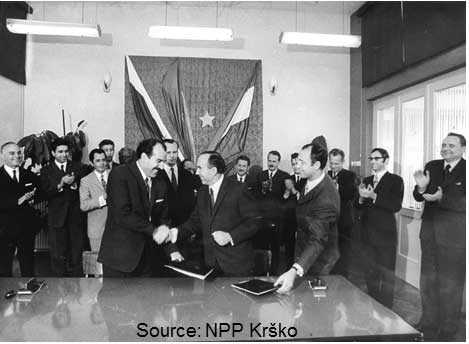
Stane Kavcic and Dragutin Haramija signed an agreement for the construction of nuclear power plant Krško on October 27, 1970.
http://www.euronuclear.org/e-news/e-news-50/linn.htm
Protective gas chamber furnace with gastight muffle for heat treatment processes under protective gas atmosphere up to 1050°C. Useful chamber 60 - 480 l and according to customer specification. For soldering and annealing processes of workpieces, scalingfree treatment of sensitive steel qualities, debinding and sintering processes, oxidation or reduction of surfaces and many more applications, under controlled atmosphere.

KS-3-480-S-Sonder
A huge selection of options enables universal application:
Inconel muffle for a maximum operating temperature up to 1150 °C
3-zone-control
gas feeding, burning-off device and flame supervision
safety package (H2-operation)
gas ventilation
fast cooling
gas quenching with heat exchanger
vacuum up to 800 °C
http://www.euronuclear.org/e-news/e-news-50/l-3.htm

MONTREAL, January 21, 2016 – L-3 MAPPS announced today that it has won an order from Societatea Nationala Nuclearelectrica S.A. (“SNN”), a Romanian-based state-owned utilities company, to upgrade the Cernavodă full scope simulator’s emulation of the plant Digital Control Computers (DCCs). DCC systems are used to monitor and control the major reactor and power plant functions at CANDU* nuclear power plants. The project will start immediately and the upgraded software is expected to be in service on the simulator in the first quarter of 2017.
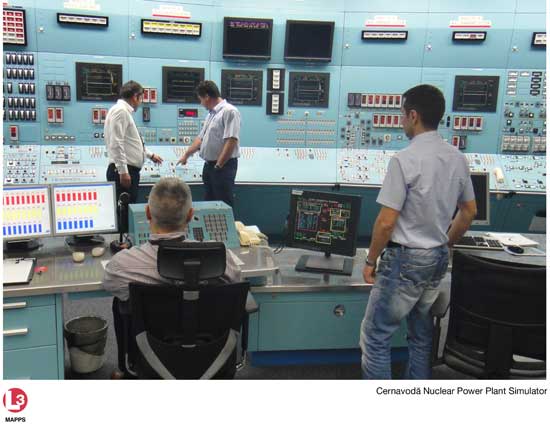
“This project brings together our nuclear power plant simulation know-how and our experience in building the actual plant DCC hardware to provide a comprehensive emulation solution to SNN,” said Michael Chatlani, vice president of marketing & sales for L-3 MAPPS Power Systems and Simulation. “We are honored to continue our long-standing working relationship with SNN and to have another opportunity to demonstrate why L-3 MAPPS is the de facto maker of CANDU plant simulators.”
“SNN has worked with L-3 MAPPS since 1984 to develop the Cernavodă plant computers for Units 1 and 2 and the full scope operator training simulator,” said Ionel Bucur, director, CNE Cernavodă. “We are pleased to have long-lasting partnerships with reliable suppliers like L-3 MAPPS to ensure the continued safe operation of our generating assets.”
The current Linux-based DCC simulation on the Cernavodă full scope simulator emulates a single SSCI-125 computer’s instruction set and the handling of the input and output (I/O) devices managed by the DCC. The upgraded simulator will feature a dual-redundant DCC emulation on a Windows operating system with the SSCI-890 computer and related I/O. The DCC emulation is developed with L-3 MAPPS’ Orchid® Control System.
The DCC emulation supports standard DCC features, such as system switchover, failover and the ability to fail individual programs. It also includes advanced built-in debugging and monitoring tools for a better understanding of the behavior of the DCC executive programs. Additionally, the emulation supports all standard simulation commands, such as freeze, run, store and backtrack. The main control room display system is also reproduced, complete with soft DCC keyboards, enhancing the portability of the solution for engineering studies and classroom training.
Societatea Nationala Nuclearelectrica S.A. (“SNN”) operates the only nuclear power plant in Romania. The electricity annually generated by Cernavodă Units 1 and 2 represents approximately 18 percent of Romania’s overall electricity production. Units 1 and 2 have been in commercial operation since December 1996 and October 2007, respectively. Both units are 706 MWe CANDU units.
L-3 MAPPS has over 30 years of experience in pioneering technological advances in the marine automation field and over 40 years of experience in delivering high-fidelity power plant simulation to leading utilities worldwide. In addition, the company has more than four decades of expertise in supplying plant computer systems for Canadian heavy water reactors. L-3 MAPPS also provides targeted controls and simulation solutions to the space sector. To learn more about L-3 MAPPS, please visit the company’s website at www.L-3com.com/MAPPS.
Headquartered in New York City, L-3 employs approximately 38,000 people worldwide and is a leading provider of a broad range of communication and electronic systems and products used on military and commercial platforms. L-3 is also a prime contractor in aerospace systems. The company expects 2015 sales of $10.4 billion, excluding National Security Solutions (NSS). To learn more about L-3, please visit the company’s website at www.L-3com.com.
http://www.euronuclear.org/e-news/e-news-50/snetp.htm


The Sustainable Nuclear Energy Technology Platform (SNETP) brings together members from all major nuclear industrial and research players (including industry - both utilities and vendors - research organisations, technical safety organisations, academia, civil society organisations, NGOs). Formally launched in September 2007, SNETP represents a major effort to better coordinate research activities in the area of nuclear fission safety and systems, and to collaborate more effectively in implementing research of strategic importance for Europe.
SNETP has released the 2015 edition of its Deployment Strategy. The document was first issued in 2010 and was updated to take stock of evolutions in the nuclear and energy context in the past five years.
This document complements the Strategic Research & Innovation Agenda, and aims to prioritise the SNETP programme over the coming decades to make it fully aligned with the general context of electricity generation in Europe, which includes different energy sources, different national energy policies and societal challenges.
The SNETP community has established a global and integrated vision of the R&D programme to be implemented for the next decades and to support the current and future nuclear systems, in consultation with other European technology platforms, and for the sake of consistency with the development of other, non-nuclear electricity sources.
With a strong commitment and contribution from industry, research, academia and safety organisations, the Deployment Strategy is now available for download.
Download: www.snetp.eu/snetp-releases-its-deployment-strategy-2015
http://www.euronuclear.org/e-news/e-news-50/eurosea.htm

The recent techniques of protein synthesis, together with the progress of biological knowledge on the structure of neoplastic cells and the improvement of microdosimetry methods have provided a remarkable contribution to the development of the Neutron Capture Therapy (NCT).
This novel technique can be applied to the treatment of some types of tumors which give an unsatisfactory reaction to conventional medical treatments (traditional radiotherapy and chemotherapy).
More recently, the NCT allows to obtain an improvement of the quality of life for the patient, a general extension of the life expectation of the treated patients and in some cases the complete healing (for example the technique of the autotransplantation applied for liver metastasis in Pavia, Italy [1]).
This article contains the preliminary description of a Facility based on a Compact Neutron Generator (CNG) for NCT applications into the hospital environment.
In 2001, an agreement between the Italian non-profit association EUROSEA Committee (based in Turin) and Lawrence Berkeley National Laboratory (LBNL) for the development of a prototype of CNG for medical uses. The Plasma and Ion Source Technology Group at Lawrence Berkeley National Laboratory (LBNL) – California USA – has been developing for over 10 years the design several CNGs for medical and industrial applications based on the nuclear fusion reactions.
At the end of 2004, thanks to Compagnia di San Paolo funding, a prototype called EUROSEA001 was installed and tested at the Experimental Physics Department of the Turin University.
Fusion-based sources, which exploit fusion nuclear reactions of light elements to produce elementary particles as neutrons, are promising devices with wide application field which ranges from radiotherapy, to clinic diagnostics, radioisotopes production and radiography for industry and security.
Nuclear fusion reactions among deuterium or tritium nuclei are exploited in fusion-based accelerators for the production of neutrons (Fig. 1). The deuterium ionized atoms (D+) or tritium (T+) are accelerated in the vacuum chamber until they hit a titanium target making fusion reactions with previous impinged D+. From the fusion reactions fast neutrons of energy 2.45 MeV (or 14.1 MeV in the case of tritium) are emitted, suitably slowed down and addressed toward the utilization region for medical and industrial applications.
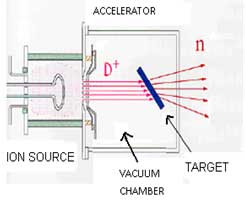
Fig. 1. Conceptual scheme of a fusion based neutron source for the production of neutrons.
The prototype EUROSEA 001 (see figure 2) is basically composed of three main elements:
a source of deuterium ions;
a low voltage electrostatic accelerator;
a titanium target.
The main characteristics of the prototype are:
high compactness (dimensions do not exceed 50 cm.);
safety (neutron production is stopped when the electrical supply is turned off);
simplicity of assembly and operation throughout the life cycle.
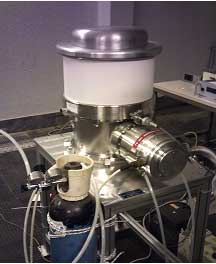
Fig. 2. Compact Neutron Generator EUROSEA 001
In figure 3 is shown a simplified scheme of CNG Facility for hospital applications.
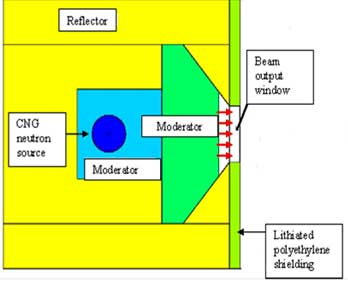
Fig. 3. Simplified scheme of a facility for the hospital application of NCT
The moderator and reflector allow to limit leakage and slow down neutrons, optimizing their energy in order to irradiate the tumoral mass.
Figure 4 shows a three-dimensional image of a Facility for the application of NCT in hospitals. This Facility, equipped with the shields and the safety devices, should be installed in a conventional radiotherapy unit.
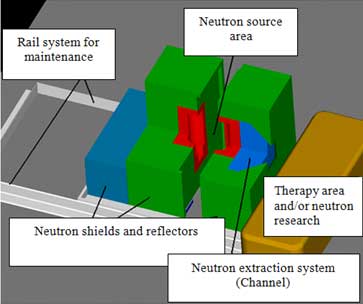
Fig. 4. Facility for the therapeutic application of NCT (artistic view)
The Facility is flexible and, using different Beam Shape Assemblies (BSA), is possible to treat different neoplasias.
In figure 5 is showed an example of layout of a radiotherapy unit involved in the application of NCT with the use of CNG Facility.
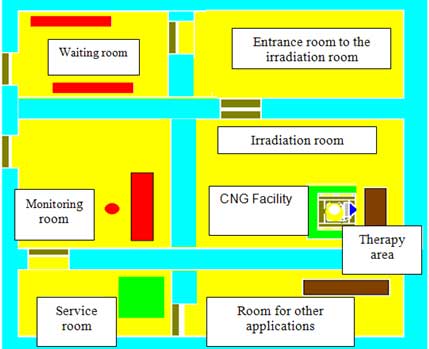
Fig. 5. Layout of a radiotherapy unit based on a CNG Facility
An extensive set of MCNP simulations showed that using the CNG EUROSEA 001 coupled with a suitable Beam Shaping Assembly (BSA).
Calculations show that it is possible to perform NCT in hospitals both using thermal neutron flux with the autotransplantation technique and using epithermal neutron flux for in situ deep tumors.
Using a CNG similar to EUROSEA 001 with 2 x 1012 n/s neutron yield [2], coupled with a suitable BSA, it is possible to obtain an epithermal and thermal neutron flux matching all the parameters for the application of NCT to in situ deep tumors [3].
References
[1] S.Bortolussi and S.Altieri, Thermal Neutron Irradiation Field Design for Boron Neutron Capture Therapy of Human Explanted Liver, Medical Physics, December 2007 Vol. 34, Issue 12, pp. 4700-4705.
[2] S. Custodero, K. Leung, F. Mattioda, Feasibility Study for the Upgrade of a Compact Neutron Generator for NCT Application, ICNCT 13, International Conference on Neutron Capture Therapy, 2-7 November 2008, Florence – Italy
[3] S. Custodero, F. Mattioda, Thermal Neutron Flux for NCT Application by means of Compact Neutron Generators, ICNCT 13, International Conference on Neutron Capture Therapy, 2-7 November 2008, Florence – Italy
Contact for EUROSEA: www.eurosea.org, eurosea@envipark.com,
Salvatore Custodero, Fulvio Mattioda and Mara Mollo
http://www.euronuclear.org/e-news/e-news-50/EC.htm


The European Commission's DG R&I has launched a stakeholders' consultation on the "Research Infrastructure long-term sustainability". The objective is to gather views on the issues which need to be addressed to ensure the long-term sustainability of Research Infrastructures as well as to identify trends and actions that should be reviewed at regional, national and European levels.
![]() download questionnaire "Consultation on Long Term sustainability of Research Infrastructures"
download questionnaire "Consultation on Long Term sustainability of Research Infrastructures"
The objective of the questionnaire is to gather stakeholders' views on the aspects which need to be addressed to ensure the long-term sustainability of RI, such as, scientific excellence, training and access, innovation potential, interaction with industry, socio-economic impact, data management, upgrading, decommissioning, governance and funding models as well as international cooperation.
This consultation will help identify the pre-conditions for sustainability and the corresponding actions that should be implemented at regional, national and European levels.
Taking advantage of the momentum that will be created by the update of the ESFRI Roadmap in the first half of 2016, the outcome of this consultation will contribute to an open policy debate among policy-makers and RI managers on the long-term sustainability of RI.
![]() download draft note on Fission
download draft note on Fission
http://www.euronuclear.org/e-news/e-news-50/Council-EU.htm

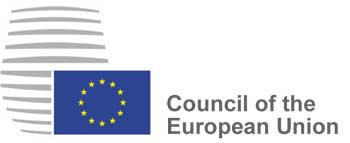
The Commission submitted the recommendation for a Council Decision1 to the Council on 29 October 2015, based on Article 101(2) of the Treaty establishing the European Atomic Energy Community.
Following the examination of the proposal by the Joint Research / Atomic Questions Working Party, completed on 25 January 2015, it has been verified that the text for the recommendation for a Council Decision was supported by a qualified majority of delegations. The Austrian, Danish and Luxembourg delegations have indicated their opposition to this Decision.
It is suggested, therefore, that the Permanent Representatives Committee recommend that the Council
adopt as an "A" item, by qualified majority, with the Austrian, Danish and Luxembourg delegations voting against, the Council Decision approving the conclusion by the European Commission, on behalf of the European Atomic Energy Community, of the Agreement extending the Framework Agreement for international collaboration on research and development of Generation IV nuclear energy systems, as finalised by the legal linguists and set out in doc. 5297/16 RECH 5 ATO 1 + ADD1.
request publication of the Decision in the Official Journal of the European Union for information.
1 Doc. 13597/15.
http://www.euronuclear.org/e-news/e-news-50/euratom.htm

The European Atomic Energy Community (Euratom) will continue supporting international collaboration for research and development of Generation IV nuclear energy systems after a recommendation of the EU Council of Ministers Working Group was published on 29 January 2016. The recommendation of the Council to extend Euratom’s participation in the Generation IV International Forum (GIF) for another period of 10 years (until 2026) and to continue in the pooling of effort to develop new nuclear energy system designs is significant.
The EU is a leader in nuclear expertise and can claim some of the best nuclear innovation and research in the world, relying on state of the art skills and infrastructures. Sustaining this leadership, the Horizon 2020 programme for research and innovation currently includes 29 nuclear-related projects financed by the EU.
The GIF recognises six advanced nuclear power systems as most likely to be deployed first: the sodium-cooled fast reactor (SFR), the lead-cooled fast reactor (LFR), the very high temperature reactor (VHTR), the molten salt reactor (MSR) and the gas-cooled fast reactor (GFR).
European nuclear research consortia are in the process of designing, developing and constructing four demonstration reactors using three of the six technologies listed above:
The ASTRID project, a prototype sodium-cooled fast reactor, will be built in Marcoule, France, starting around 2020.
The ALLEGRO project, a gas-cooled fast reactor demonstration project to be constructed in the Czech Republic, Hungary or Slovakia.
The ALFRED project, a lead-cooled fast reactor demonstration project will be built in Pitesti, Romania, starting in 2020.
Additionally, the MYRRHA research reactor project, a lead-bismuth cooled accelerator-driven fast neutron multi-purpose research reactor, is also being developed. Belgium’s SCK-CEN research centre leads the project which is already under construction and will be operational at Mol, Belgium, around 2020.
Furthermore, through the European Sustainable Nuclear Industrial Initiative (ESNII) the EU has set out the research and innovation needs for the future of Generation IV fast reactor systems. ESNII coordinates the research for Generation IV reactors and its main objective is to maintain European leadership in fast spectrum reactor technologies that will excel in safety and will be able to achieve a more sustainable development of nuclear energy. It prioritises the development of the ASTRID, ALFRED and ALLEGRO projects as essential for Europe in order to maintain its skills and leadership in the international nuclear community.
The realization of such initiatives will constitute a break-through in terms of nuclear energy sustainability in the long term and is believed essential for maintaining European leadership in the nuclear energy sector.
http://www.euronuclear.org/e-news/e-news-50/other-conferences.htm

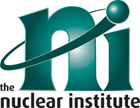
25 February 2016
Church House, Westminster, London, UK
more

10 March 2016
Mercure Hotel, Portland St., Manchester, UK
more

12 - 14 April 2016
Dan Panorama Hotel, Tel-Aviv, Israel
more
![]()
17 - 22 April 2016
Charleston Mariott Hotel, Charleston, South Carolina, USA
more
 |
 |
20 - 21 April 2016
Casta-Papiernicka, Slovakia

10 - 12 May 2016
Hamburg, Germany
more

5 - 8 June 2016
Zadar, Croatia
more

8 - 9 June 2016
St. Ermin's Hotel, Westminster, London, UK
more
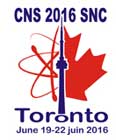
19 - 22 June 2016
Toronto, Canada
more

July 2016
Pittsburg, USA
more
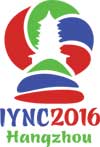
24 -30 July 2016
Hangzhou, China
more
5 -8 September 2016
Portorož, Slovenia
more
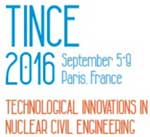
5 - 9 September 2016
Paris, France
more

11 -16 September 2016
Boise, Idaho, USA
more

19 - 23 September 2016
Mercure Hotel, Aachen, Germany
more

28 - 30 September 2016
Santander, Spain
more

September 2016
Bratislava, Slovakia

2 - 7 October 2016
Brighton UK
more
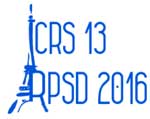
3 - 6 October 2016
Paris, France
more
![]()
22 - 24 November 2016
World Conference Center, Bonn, Germany
more
http://www.euronuclear.org/e-news/e-news-50/Member-Societies.htm

Austrian
Nuclear Society |
Belgian
Nuclear Society |
Bulgarian
Nuclear Society |
Croatian
Nuclear Society |
Czech Nuclear Society |
Finnish
Nuclear Society |
French
Nuclear Energy Society (SFEN) |
German
Nuclear Society (KTG) |
Hungarian
Nuclear Society |
The
Israel Nuclear Society |
Italian
Nuclear Association |
Lithuanian
Nuclear Energy Association |
Netherlands Nuclear Society |
The Nuclear Institute |
Nuclear
Society of Russia |
Nuclear
Society of Serbia |
Nuclear
Society of Slovenia |
Polish
Nuclear Society |
Romanian
Nuclear Energy Association (AREN) |
Slovak
Nuclear Society |
Spanish
Nuclear Society |
Swedish
Nuclear Society |
Swiss
Nuclear Society |
http://www.euronuclear.org/e-news/e-news-50/Corporate-Members.htm
Links to ENS Corporate Members |
Aachen Institute for Nuclear Training GmbH |
Alpiq Suisse Ltd. |
Andritz AG |
Ansaldo Nucleare S.p.A |
AREVA NP GmbH |
Atomtex SPE |
BKW FMB Energie AG |
Electrabel GDF Suez |
NV Elektriciteits-Produktiemaatschappij
Zuid-Nederland EPZ |
E.O.N Kernkraft GmbH |
Electricité de France (EDF), Communication Division |
Elektroinstitut Milan Vidmar |
ENUSA Industrias Avanzadas SA |
EXCEL Services Corporation |
GE Hitachi Nuclear Energy International |
IEA of Japan Co. Ltd |
Kernkraftwerk Gösgen-Däniken
AG |
Kernkraftwerk Leibstadt AG (KKL), |
L-3 Communications MAPPS Inc. |
Linn High Therm GmbH |
MVM Paks Nuclear Power Plant Ltd |
NRG |
NUKEM Technologies GmbH |
Paul Scherrer Institute |
SKB (Swedish Nuclear Fuel and Waste Management
Company) |
|
Studiecentrum voor Kernenergie, Centre d’Etude
de l’Energie Nucléaire SCK-CEN |
SVS FEM |
Synatom |
Teollisuuden Voima Oyj / Industrial Power
Company Ltd (TVO) |
Tractebel Engineering S. A. |
UNESA |
Urenco Limited |
Vattenfall AB |
VNS – Vinçotte Nuclear Safety |
VTT Nuclear |
Westinghouse Electric Company |
World Association of Nuclear Operators
(WANO), |
http://www.euronuclear.org/e-news/e-news-50/editorial.htm

Editorial Staff:
Lubomit Mitev, Editor-in-Chief
Contributors to this Issue:
Carl Berglöf (SKS, Sweden)
Noel Carmarcat (ENS)
Salvatore Custodero (EUROSEA, Italy)
Kirsten Epskamp (ENS)
Nils-Olov Jonson (SKS, Sweden)
Fulvio Mattioda (EUROSEA, Italy)
Mara Mollo (EUROSEA, Italy)
Giuseppe Quartier (IUSR, Italy)
Realisation:
Marion Brünglinghaus
Avenue des Arts 56, BE-1000 Brussels
Phone +32 2 505 30 50 - Fax: +32 2 502 39 02
E-mail: info@euronuclear.org - http://www.euronuclear.org
The ENS News is a quarterly publication, in electronic
form only.
Copyright notice ©2016 European Nuclear Society.
Reproduction is authorised provided that the ENS News is acknowledged as the
source – except where otherwise stated.
![]()
© European Nuclear Society, 2016